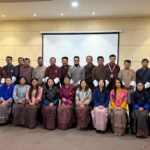For landlocked Bhutan characterized by rugged terrain and harsh climatic conditions, the highly adapted traditional horse breeds played an unfailing role in country’s trade during the pre-modernization era. It continues to play an important role in many parts of the country where motorable road has not yet reached. However, the horse population in the country is rapidly declining due to various factors, including their diminishing utility. Reducing population size leads to inbreeding which in turn affects survival, performance and productivity. Assessment of genetic diversity is one of the tools to determine the status of the diversity and develop strategies for effective management of animal genetic resources.
As the National Biodiversity Centre (NBC) is mandated to promoting conservation and sustainable utilization of biodiversity, in particular of the traditional genetic diversity, a team from Animal Genetic Resources Program of NBC assessed the genetic diversity and population structure of Bhutanese traditional horses (Yuta, Boeta and Sharta) using the standard DNA microsatellite genotyping tools.
The following are the key findings from the study:
- The genetic diversity in traditional horse population was high with low levels of inbreeding. This is expected due to the optimum population which is still available, the lack of specific horse breeding programs and prevailing random mating practices in the country.
- Genetic differentiation among the traditional breeds was however low. The can be attributed to lack of isolation of breeds and a high level of genetic exchanges among the horse breeds (interbreeding) observed.
Overall, this study suggests that the traditional horse breeds of Bhutan are genetically less differentiated. However, a high individual genetic diversity provides an optimistic outlook for the survival of the declining traditional horse population, if appropriate management interventions are implemented.
Full publication of the study is available from http://journals.plos.org/plosone/article?id=10.1371/journal.pone.0199376 or http://biodiversity.bt/document/show/193
Submitted by: NBC




